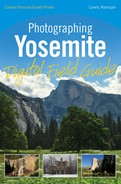28.3. How Can I Get the Best Shot?
By scouting different locations from the areas adjacent to the chapel and having the proper lenses, filters, and equipment, as well as using the proper settings on your camera, you can create unique images of Yosemite Chapel. Using the proper shutter speed to stop the action of the falling snow in figure 28.1 helped make this image much more exciting.
Figure 28.1. The Yosemite Chapel in a winter snowstorm in late morning. Taken at ISO 400, f/11, 1/125 second with a 100-400mm lens at 180mm.

28.3.1. Equipment
You want to use a variety of lenses when photographing Yosemite Chapel. The addition of a polarizing filter and using your tripod and bubble level will help you get the best images.
28.3.1.1. Lenses
Your wide-angle lenses are most useful when you are getting up close to the chapel and want to include some of the surrounding cliffs in your images. When photographing buildings with wide-angle lenses, you have to worry about distortion from tilting the camera. Try to keep your camera level if you can. If you do a lot of architectural photography, you may want to consider using a tilt-shift lens. These lenses are designed for architectural work, where the front of the lens actually rises so you don't have to tilt the camera. These are specialty lenses and can be rented in some cities. Check camera stores that cater to professionals in major cities if you are interested in trying one of these lenses. Your other option is to fix the distortions in an image-editing program.
If you use longer focal length lenses, then this distortion does not become an issue. If you photograph the chapel from across Southside Drive, then you will most likely be using your longer zooms in the 100-300mm range.
28.3.1.2. Filters
A polarizing filter reduces the glare off the surrounding vegetation, making their colors in the photograph richer and more saturated. The same filter helps to darken the skies and accentuate the clouds if you choose to use a wide-angle lens and include the sky.
28.3.1.3. Extras
A tripod and cable release ensure sharp images and allow you to set your lens to a small aperture and give you more depth of field so that the chapel, the trees, and the cliffs will all be in sharp focus.
28.3.2. Camera settings
When photographing the Yosemite Chapel, the highest priority is depth of field. You want to have everything in focus, from the close foreground to the distant background cliffs.
ISO. Using the native ISO of your camera (the ISO recommended by the camera manufacturer) always gives you the best image. If you are using a tripod, using this native ISO will not be difficult and it will allow you to keep the camera steady if your shutter speeds start to get longer. If you are handholding the camera, you may want to boost the ISO to 400 or higher so that you can set the lens to a smaller aperture and still have a fast enough shutter speed to be steady.
Exposure mode. Because depth of field is the foremost concern, using Aperture Priority mode, where you set the aperture and the camera sets the shutter speed, is the best choice. Choosing apertures in the f/11 to f/22 range gives you good depth of field and allows you to have sharp images.
Exposure compensation. Most of the time when you are photographing the chapel against the cliffs, you do not have much of an issue with exposure compensation. If you also include the sky, you may need to use a plus compensation if your light meter darkens the cliffs and the chapel in the image.
White balance. Daylight white balance should work well for most images taken in this area.
28.3.3. Exposure
Try to photograph the chapel when it is evenly lit, either all in shadow or all in sun. Doing so reduces the contrast and gives you better exposures.
28.3.3.1. Ideal time to shoot
The chapel is best photographed in the morning when it remains in shade or the afternoon when it is evenly lit. When the sun is farther west, the chapel is more evenly illuminated and not in the shadows of the easterly trees. Autumn adds color to the scene and winter looks like an idealized Christmas card.
28.3.3.2. Working around the weather
Some of the best, greeting-card perfect photographs of the chapel have been made during raging snowstorms. If you are photographing under these conditions, use a fast shutter speed of between 1/60 and 1/250 second to stop the motion of the snowflakes and freeze them on their descent to the valley floor. If you expose longer, the snow will appear streaked in your image.
28.3.3.3. Low-light and night options
Although you can photograph here at night, the south side of the valley does not receive as much moonlight as the north side, so your exposures will be longer and not as well lit.
28.3.3.4. Getting creative
To get creative, walk around the chapel and explore it from all sides. Try to frame the chapel between branches of a tree or get low and use the tall grasses as foreground elements. Get extremely close with a wide-angle lens and distort or exaggerate its shape (see figure 28.2). If you want to get really creative, you can try light painting, using a high-powered flashlight to "paint" light on the chapel in the evening or night.
Figure 28.2. Yosemite Chapel with Yosemite Falls in the background. Taken at ISO 100, f/20, 1/15 second with a 17mm lens.



